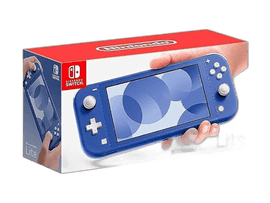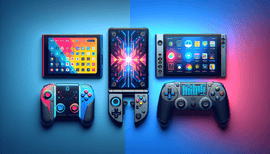The Nintendo Switch OLED Model has been making waves since its release, and for good reason. With its vibrant 7-inch OLED screen, enhanced audio, and improved build quality, it promises to elevate the gaming experience to new heights. But does it live up to the hype? Let's dive into the details and see how it fares in various categories.
Portability
One of the standout features of the Nintendo Switch OLED Model is its portability. Weighing in at just 3.09 pounds and with dimensions of 2.9 x 6.5 x 7.9 inches, it's designed to be taken on the go. The wide adjustable stand makes it easy to set up for tabletop gaming, whether you're on a plane, at a friend's house, or just lounging in your living room.
The detachable Joy-Con controllers add another layer of versatility, allowing for local co-op play without the need for additional controllers. This makes it an excellent choice for families or groups of friends who want to game together without being tethered to a TV.
Pros:
- Lightweight and compact design
- Wide adjustable stand for tabletop gaming
- Detachable Joy-Con controllers for local co-op
Cons:
- The screen, while durable, is still susceptible to scratches and damage if not handled carefully
Battery Life
Battery life is a critical aspect of any portable gaming console, and the Nintendo Switch OLED Model doesn't disappoint. Depending on the game, you can expect anywhere from 4.5 to 9 hours of playtime on a single charge. This is a slight improvement over the original Switch, thanks to the more energy-efficient OLED screen.
However, it's worth noting that more graphically intensive games will drain the battery faster. For instance, playing "The Legend of Zelda: Breath of the Wild" will give you closer to 4.5 hours, while less demanding games can stretch that to the upper end of the range.
Pros:
- Improved battery life compared to the original Switch
- Energy-efficient OLED screen
Cons:
- Battery life can vary significantly depending on the game being played
Game Library
The Nintendo Switch OLED Model benefits from the extensive game library that the Switch ecosystem offers. From first-party titles like "The Legend of Zelda: Breath of the Wild" and "Super Mario Odyssey" to third-party hits like "The Witcher 3" and "Doom," there's something for everyone.
Moreover, the Switch has a robust indie game scene, offering unique titles that you won't find on other consoles. The inclusion of older Wii U titles like "Mario Kart 8 Deluxe" and "Donkey Kong Country: Tropical Freeze" also adds value, especially for those who missed out on the Wii U era.
Pros:
- Extensive library of first-party and third-party games
- Strong indie game presence
- Inclusion of popular Wii U titles
Cons:
- Some games, especially third-party titles, may not perform as well as their counterparts on more powerful consoles
Performance
When it comes to performance, the Nintendo Switch OLED Model holds its own but isn't without its limitations. The console uses the same NVIDIA Tegra X1 processor as the original Switch, which means that while it can handle most games well, it may struggle with more demanding titles.
Frame rate drops and occasional lag can be an issue, particularly in graphically intensive games. However, for the vast majority of titles, the performance is more than adequate, and the enhanced audio in handheld and tabletop modes adds to the immersive experience.
Pros:
- Adequate performance for most games
- Enhanced audio in handheld and tabletop modes
Cons:
- Occasional frame rate drops and lag in more demanding games
- Uses the same processor as the original Switch, limiting performance improvements
Display Quality
The 7-inch OLED screen is the crown jewel of the Nintendo Switch OLED Model. The vibrant colors and deep blacks make games look stunning, whether you're exploring the vast landscapes of Hyrule or racing through the tracks in "Mario Kart 8 Deluxe." The screen is also slightly larger than the original Switch's 6.2-inch display, providing a more immersive gaming experience.
The OLED technology not only improves color accuracy but also enhances battery efficiency, making it a win-win for gamers. However, the screen's glossy finish can be prone to glare in bright environments, so finding the right lighting conditions is essential for the best experience.
Pros:
- Vibrant 7-inch OLED screen with deep blacks and rich colors
- Slightly larger screen size compared to the original Switch
- Improved color accuracy and battery efficiency
Cons:
- Glossy finish can be prone to glare in bright environments
Special Features
The Nintendo Switch OLED Model comes with several special features that set it apart from its predecessors. The 64 GB of internal storage is a welcome upgrade, though a portion is reserved for system use. This still leaves ample space for games and saves, and the storage can be expanded with a microSD card.
The console also supports local co-op, online, and local wireless multiplayer, making it a versatile option for various gaming scenarios. The enhanced audio in handheld and tabletop modes further elevates the gaming experience, providing clear and immersive sound.
Pros:
- 64 GB of internal storage, expandable with a microSD card
- Supports local co-op, online, and local wireless multiplayer
- Enhanced audio for a more immersive experience
Cons:
- A portion of the internal storage is reserved for system use
Missing Features
While the Nintendo Switch OLED Model is an impressive piece of hardware, it's not without its shortcomings. One of the most notable missing features is the lack of significant performance upgrades. The console still uses the same NVIDIA Tegra X1 processor as the original Switch, which limits its ability to handle more demanding games.
Another issue is the ongoing problem of Joy-Con drift, where the analog sticks register movement even when not being touched. While it's unclear if the OLED Model has addressed this issue, it's something potential buyers should be aware of.
Pros:
- Impressive hardware and features
- Enhanced display and audio
Cons:
- No significant performance upgrades
- Ongoing issue of Joy-Con drift
Conclusion
The Nintendo Switch OLED Model is a fantastic upgrade for both new and existing Switch owners. Its vibrant OLED screen, enhanced audio, and improved build quality make it a joy to use, whether you're gaming at home or on the go. While it doesn't offer significant performance upgrades, its extensive game library and versatile features make it a compelling choice for gamers of all ages.
If you're in the market for a portable gaming console with a rich library of games and excellent display quality, the Nintendo Switch OLED Model is hard to beat. Just be mindful of its limitations and the potential for Joy-Con drift, and you'll find it to be a worthy addition to your gaming arsenal.
Final Rating: 4.8/5
SEO Keywords: Nintendo Switch OLED Model, portable gaming console, OLED screen, enhanced audio, game library, performance, display quality, Joy-Con drift, battery life, local co-op, multiplayer gaming.





